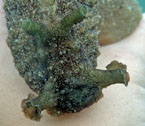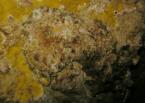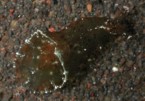| Home |
| Acknowledgments |
| Conventions |
| Glossary |
| Maps |
| References |
| Links |
| Articles |
| Thumbnails |
| Species
list |
| Family |
| Next
species |
Additional Photos

front

dark

intermediate

small tubercles

young, 5.5 mm

"hiding"

ejecting ink

possible predation

shell

egg mass
_______________
GALLERY

Dolabella auricularia (Lightfoot, 1786)

| Maximum size: about 300 mm. (Note 1) Identification: This is one of the largest opisthobranchs in Hawaii. The body is wedge-shaped with a small head and a broad, flattened posterior disk. The parapodia are fused except for circular apertures anterior to and in the center of the disk. The surface is intricately tuberculate. The color is highly variable ranging from dark brown through mottled brown and green to whitish. (Note 2) Natural history: Dolabella auricularia is a common species found in mixed habitats and rocky areas both in tide pools and subtidally at depths of < 1 to 21 m (< 3 to 70 ft). It occurs in highly protected to moderately exposed locations. It's nocturnal, concealing itself in crevices or under rocks during the day. When disturbed, it ejects purple dye through the aperture in the center of the posterior disk. (Note 3) It lays a tangled, spaghetti-like egg mass similar in appearance to the egg masses of Aplysia spp. Because of its large size, dead animals are occasionally found on beaches. (see photo) (Note 4) Distribution: Big Island, Maui, Molokai, Oahu, Kauai, Niihau, French Frigate Shoals and Midway (also Johnston Atoll): widely distributed in the Indo-Pacific; also in the eastern Pacific. Taxonomic notes: It's referred to as the "eared sea hare" in Hoover, 1998 & 2006. It was first reported from Hawaii in Pease, 1860 (as Dolabella variegata) and is listed under that name in Edmondson, 1946 and Ostergaard, 1955. There's some chance that the "small tubercles" form could prove distinct with future work. Photo: CP: light: Honokohau Harbor, Big Island; Nov. 19, 2011. Observations and comments: Note 1: An unmeasured animal seen by CP at Mala Wharf may have approached 350 mm. Note 2: We've seen light and dark animals copulating in the field. Note 3: On several occasions, we've observed an animal responding to a flashlight beam by crawling into a crevice and flattening out its posterior disk to block the entrance. (see photo) When prodded, they ejected dye from the aperture in the center of the disk. Presumably, this might discourage pursuing predators. Note 4: On at least three occasions we've observed Dolabella auricularia being eaten by other animals during the day. On Aug. 21, 1989 a bigeye emperor (Monotaxis grandocularis) spotted one on the bottom and went down to pick it up. It appeared very chewy and it took the emperor several minutes to eat it. All the while, purple ink was pouring out of its mouth. On May 25, 2015 about five emperors were observed competing for the body of another animal. On March 15, 1990 we observed a banded spiny lobster (Panulirus marginatus) holding and eating the remains of one. Autumn Hill also observed a banded spiny lobster feeding on the remains of one on April 4, 2015. (see photos) Twice, we've seen animals with chunks bitten out of them near stripebelly puffers (Arothron hispidus) suggesting that it also preys on the species. |
| Thumbnails |
Species
list |
Family | Next species | Top |